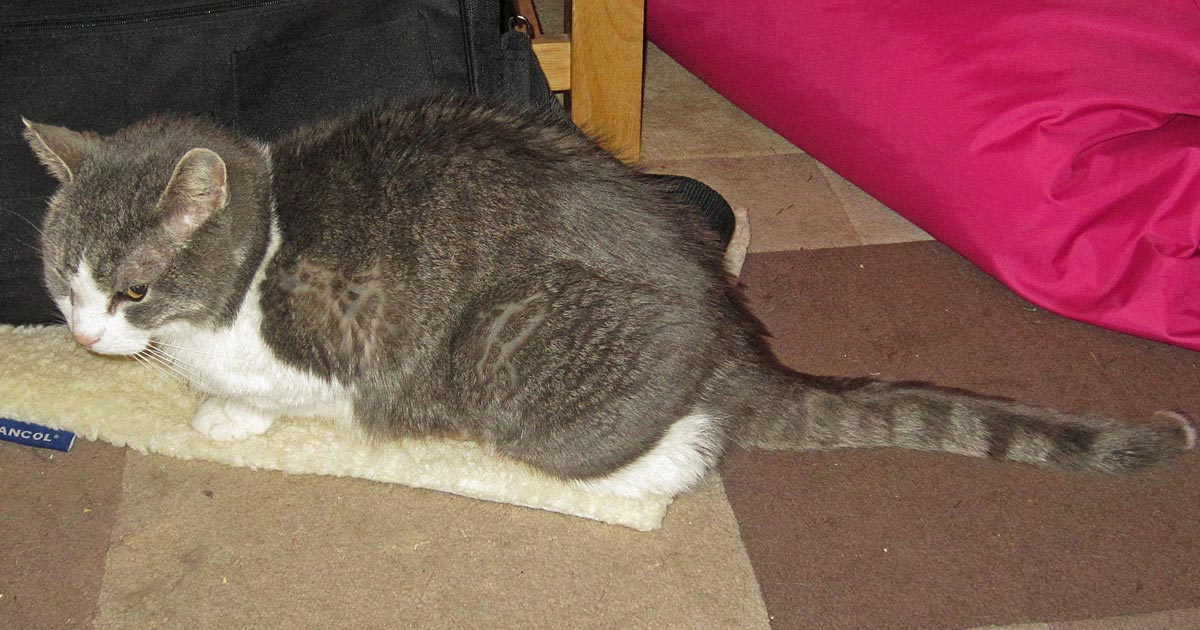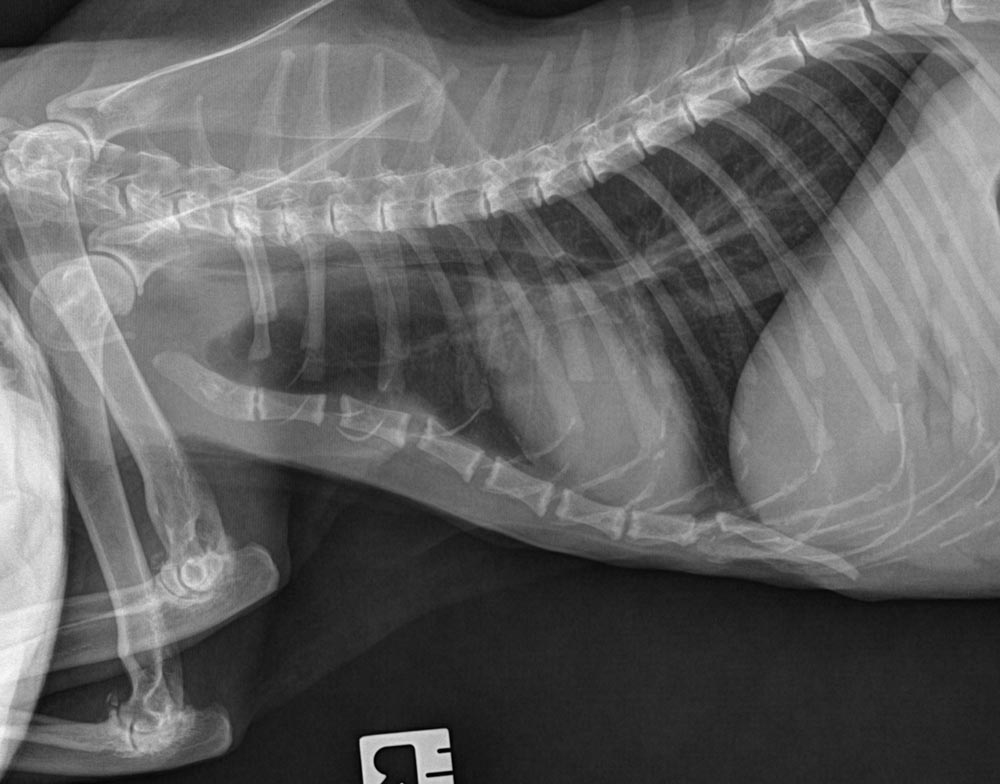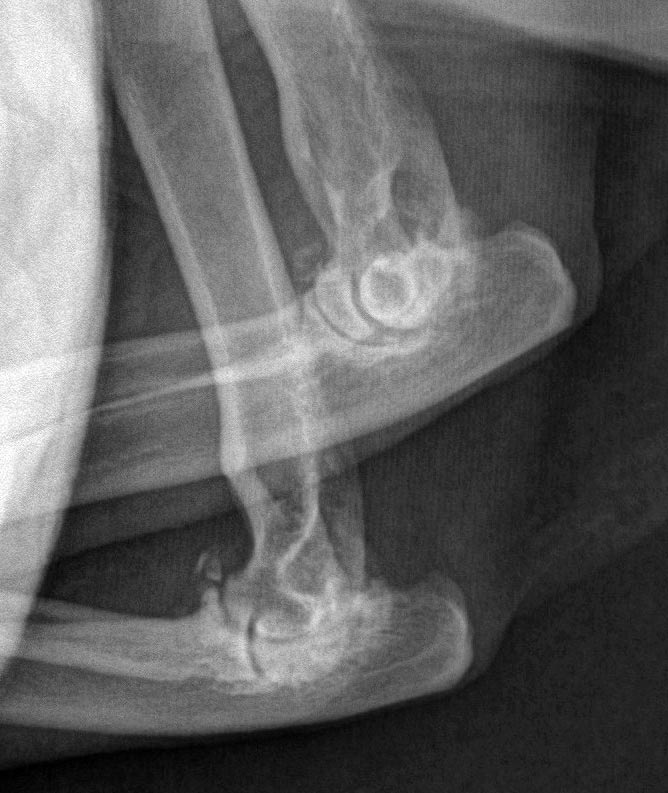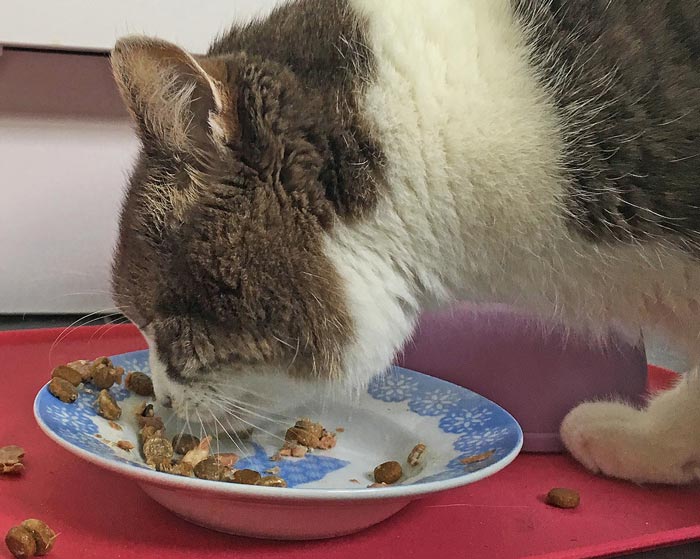26 Nov 2018

Figure 1. The hunched posture of a cat suggesting possible abdominal pain.
Advances in companion animal medicine, and heightened interest in feline welfare and geriatric medicine, has led to increased awareness and recognition of the range of medical problems that may be experienced by elderly cats.
Common “age-related” diseases – which are seen with increasing frequency in an ageing cat population – include hyperthyroidism, diabetes mellitus, chronic kidney disease (CKD), various tumours and OA. Chronic pain is most likely to arise from OA or some neoplastic conditions.
The treatment of pain in cats with CKD may present a challenge, given the potential for reduced renal clearance of drugs. The requirements for treating CKD and the painful condition conflict, or that certain forms of pain management are contraindicated in CKD, may be cause for concern. However, with a good understanding of feline physiology and a sound appreciation of evidence-based medicine, we may be pleasantly surprised at the options open to us.
Owners need to be counselled in what aspects to look for in their cat that may indicate disease, rather than accepting alterations to activity levels, appetite, demeanour and personal care are merely “ageing changes” that cannot be addressed. As vets, we too need to be aware of the best way to question owners to maximise historical information, as cats will not always display obvious signs of pain (Figure 1).

In human medicine, renal clearance studies form the basis for drug dose adjustments in CKD patients; however, this luxury is rarely practical or affordable in veterinary medicine. Formulas used to calculate alterations to the dosing regimen cannot be based on serum creatinine or symmetric dimethylarginine levels alone. Nevertheless, the clinician should be mindful of the effect of reduced renal function on the potential for accumulation and toxicity of various drugs.
As a rule of thumb, whenever a drug is more than 70% excreted via the renal route, the dose or dosing frequency may need to be altered in a patient with CKD. The breadth of the therapeutic window of the drug should also be borne in mind; dose reductions are more likely to maintain steady state concentrations, but may run the risk of accumulation, so for the drugs with a greater potential for toxicity, a decreased dosing frequency may be a safer approach – even if this leads to times where plasma concentrations fall below the therapeutic level.
OA should be accepted as common, and seen with increasing frequency in ageing cat populations, yet our ability to adequately recognise and manage the condition in individuals may still be hampered – particularly if the habit patterns formed from canine medical practice cannot be suitably altered to accommodate our feline patients.
Accurate in-clinic musculoskeletal pain assessment in the cat is difficult and no standard technique exists. Because of this, the impact on the welfare of elderly cats with OA has probably been long underestimated.
Occasionally, joint discomfort, crepitus and/or reduced range of motion may be apparent on examination, but more typically, findings do not correlate well with radiographic changes. These can be marked and include the presence of osteophytes, appearing as roughening of the joint surface or more obvious bony spurs, secondary soft tissue swelling and, in advanced cases, bone remodelling and sclerosis of subchondral bone. A proactive approach to the diagnosis of OA is required (Figures 2 and 3).


Careful questioning of the owner as to the cat’s demeanour and activity levels may reveal clues – indicating the cat is experiencing significant discomfort due to OA.
In cats, OA rarely causes overt lameness, but more usually results in decreased activity levels, a reduced repertoire of active behaviours, decreased grooming, difficulty using the litter tray, reduced ability or willingness to jump or climb and resentment of handling. Cold and damp weather typically exacerbates signs, and discomfort and stiffness will usually be worse after a rest following activity.
If the results of “pain questionnaires” and radiography are inconclusive, or if sedation and radiography are declined – or for any reason undesirable – a treatment trial may be considered as a method of retrospectively confirming a cat was experiencing pain.
A holistic approach to treating OA achieves the best results. Management strategies to reduce demand on the joints can be combined with pharmacological intervention. This not only helps optimise the response to treatment, but also aids medication dose reductions without loss of efficacy, therefore reducing the potential for toxicity and side effects.
The environment can be modified, providing soft beds positioned near to the ground, but in secluded spaces; ramps to litter trays and slopes placed over steps; and organising bedding, water and food to be kept downstairs to minimise painful negotiation of steps.
Weight loss is advised in obese cats. Diets supplemented with omega-3 fatty acids have proven efficacy; however, a phosphate and potentially protein-restricted “renal” diet is indicated in cats with CKD (from IRIS stage II) and this is likely to take precedence. Omega-3 fatty acids could be administered separately to the cat’s renal diet, but it is difficult to achieve the concentration shown to be of benefit in diets designed for the managing of OA.
Fish liver oil, or those supplemented in vitamins D and A, must be avoided. Renal diets are usually supplemented with omega-3 fatty acids to some extent, as benefit to renal health has also been demonstrated.
“Nutraceuticals”, such as glycosaminoglycans, glucosamine and pentosan polysulphate, are frequently prescribed for OA in cats. Most studies evaluating efficacy for this indication have been carried out in dogs, and evidence for efficacy is either lacking or, in the case of pentosan polysulphate, weak. One study comparing meloxicam to glucosamine and chondroitin in cats confirmed the superiority of meloxicam, based on mobility scores generated by the owners (Sul et al, 2014).
NSAIDs are the drug of choice for the treatment of musculoskeletal pain, including that originating from OA. NSAIDs reduce inflammation, which potentiates their analgesic action in this setting.
Meloxicam is licensed for use in chronic painful and/or inflammatory musculoskeletal disorders. The drug is palatable, the liquid formulation easy to administer and, importantly, it is ideal for dose titration. Several studies have demonstrated efficacy and safety in cats. A loading dose of 0.1mg/kg is administered once, followed by a dose of 0.05mg/kg once daily. After a response is seen (usually five to seven days) it is often possible to reduce the dose further. Often the dose frequency can also be reduced without losing efficacy.
Both CKD and OA are seen with some frequency in the elderly feline population. A study suggested CKD could be expected in nearly 70% of cats with degenerative joint disease (DJD; Marino et al, 2014).
Concerns NSAIDs would be harmful to the kidney, particularly when interstitial nephritis is present, have been allayed by studies showing, not only do NSAIDs not exacerbate renal dysfunction, but a trend towards potential renoprotective effects was noted, with lower creatinine levels seen over time in cats with CKD treated with NSAIDs compared to a control group (Gowen et al, 2011; Gowen et al, 2012).
The reason for this is not clear. Speculation includes the anti-inflammatory actions of NSAIDs could ameliorate tubulointerstitial nephritis, which is, indeed, an inflammatory disease, or that oral intake – and, therefore, hydration – is improved in a comfortable patient, such that unnecessary hastening of the kidney disease, due to reduced renal perfusion, is avoided.
Whatever the reason, the fact meloxicam has been shown to do no harm when used judiciously in feline CKD patients is a valuable finding that, hopefully, means no necessary length of life trade-off for good quality of life. Some care and owner counselling is still required; NSAIDs have the potential to precipitate acute kidney injury (AKI) in cats with CKD in a dehydrated, hypotensive or hypovolaemic patient.
In CKD the kidney has lost its adaptive mechanism to reduced circulating volume as the efferent arteriole is already constricted under the effect of angiotensin II. The afferent arteriole dilates in response to prostaglandins released in response to reduced renal perfusion, but NSAIDs inhibit the synthesis of prostaglandins, preventing dilation of the afferent arteriole and preventing any compensatory increase in glomerular filtration rate.
In a well-hydrated patient, even with CKD, good renal perfusion prevents this eventuality, but in dehydration, the glomerulus can take no additional measures to protect itself against reduced perfusion, and AKI may result (Figure 4). For this reason, the use of NSAIDs for DJD at the lowest effective dose can be advocated in cats with stable CKD that are appetent with no vomiting or diarrhoea; however, the drug should be promptly ceased if the patient refuses food or develops gastrointestinal signs.

Regular monitoring of renal function is prudent. Cats with IRIS stage IV CKD may also be unsuitable candidates for NSAID use as polyuria is likely to be more marked and these cats may struggle to maintain hydration. Where NSAIDS are unsuitable for use in a cat with CKD, or in the (relatively uncommon) situation where gastrointestinal side effects occur, for welfare reasons, another form of analgesia should be prescribed where OA or other chronic condition is causing pain. Suggestions are discussed in the following section.
Palliative care of incurable neoplastic processes should include a proactive assessment for pain. Tumours involving the oral or nasal cavity, the skin or muscle and the visceral organs all have the potential to elicit pain. If overt pain cannot be detected, analgesia trials are indicated – particularly in any patient that seems subdued or is inappetent. A significant inflammatory component is common in neoplastic conditions and meloxicam may be a suitable choice of analgesia for many cases. Glucocorticoids may be an alternative way to control inflammation, if meloxicam is contraindicated.
Other conditions that may lead to an underestimated degree of pain would be the inflammatory abdominal diseases such as inflammatory bowel disease (IBD). Addressing the inflammation appropriately with diet – and, if required, immunomodulatory drugs – should lead to the resolution of pain. However, IBD can be notoriously difficult to manage in some patients and if ongoing abdominal discomfort is suspected, treatment with maropitant should be considered, as this drug is thought to have the potential to control pain and inflammation in the abdominal viscera, based on studies in rats.
Chronic pancreatitis is a condition that deserves particular mention. At times it may be diagnosed in isolation; however, a thorough search should be undertaken for associated inflammatory liver and intestinal disease, as where these are present, immunomodulatory therapy may lead to significant pain relief in the abdomen. Steroid therapy typically features in the treatment of IBD. Glucocorticoids negatively affect prostaglandin production, but their influence on the progression of kidney disease has never been objectively evaluated. Maropitant is metabolised and cleared by the liver and, as such, dose adjustments should not be necessary when renal impairment exists.
Buprenorphine may be more effective for visceral pain and it can also be administered in conjunction with meloxicam if one or the other alone is insufficient. Buprenorphine is licensed to be administered to cats via injection, but for chronic use, it would typically be used sublingually (off label).
Whether cats develop tolerance to the opioid analgesics is not clear, but clinicians should be mindful of this possibility when treating chronic pain. The opioids are metabolised by the liver and minimally renally excreted.
Few other analgesic drugs are licensed in the cat, and risk-benefit must be considered with all treatments. However, studies evaluating the pharmacokinetics of various analgesic preparations are emerging and, in some cases, efficacy has also been evaluated. Tramadol, amantadine and gabapentin are other drugs that have been the subject of occasional clinical studies in recent years.
Typically, analgesic drugs may be trialled in circumstances such as ovariohysterectomy or thermal nociception thresholds. This provides valuable information, but does not correlate well with a clinical setting of chronic pain management. Additionally, few drugs have been assessed for safety in the setting of renal impairment. Therefore, careful historical and clinical assessment is necessary to gauge individual response, and haematological and biochemical monitoring should be offered to owners where appropriate.
Tramadol (unlicensed) has demonstrated efficacy when used in cats with OA (Guedes et al, 2018). It is metabolised by the liver, which is considered preferable in a cat with CKD. A dose of 2mg/kg twice daily provided optimum results in terms of quality of life assessment; dose-dependent behavioural changes and gastrointestinal side effects were seen with some frequency.
Gabapentin is a drug typically used in various neurological diseases – including neuropathic pain in people. Although unlicensed, it has gained favour in recent years in the veterinary field, as it is considered relatively safe and, anecdotally, appears to be effective in various painful conditions. Gabapentin appeared to bring additional pain relief to buprenorphine alone – similar in efficacy to meloxicam in one study assessing its utility for surgical pain (Steagall et al, 2018).
The benefit of chronic gabapentin administration has been reported in three cats with head trauma or musculoskeletal disease (Lorenz et al, 2013). It should be noted gabapentin also causes behavioural changes, which may affect the interpretation of pain scoring systems. Gabapentin is renally excreted and a dose reduction or reduced dose frequency should be considered in cats with CKD.
Amantadine is not infrequently used in dogs for the treatment of chronic pain. The drug has been poorly studied in cats and the species may show individual patient variation in response. Drug combinations should be considered if single agents are insufficient in controlling pain. This may have the added benefit of lowering the dose of each potentially toxic drug, which may be an important consideration as CKD advances.
Finally, when aiming to achieve chronic pain control in the elderly cat with various comorbid conditions including CKD, the potential benefit of acupuncture should not be overlooked. While controlled clinical trials in veterinary patients are lacking, anecdotal reports of efficacy are available, and objective evidence is gathering of the potential for efficacy based in physiological responses.
| Table 1. Pharmacological agents used in the treatment of chronic pain in cats | ||||
|---|---|---|---|---|
| Drug and suggested dose | Mechanism of action | Route of clearance | Potential adverse effects | Evaluated in cats? |
| Meloxicam 0.1mg/kg once 0.05mg/kg once a day Then taper |
NSAID Some cyclooxygenase-2 selectivity |
Hepatic metabolism Minimal renal excretion |
Gastrointestinal Renal if dehydrated |
Yes |
| Buprenorphine 0.01mg/kg to 0.02mg/kg twice a day to three times a day |
Partial mu-agonist opioid | Hepatic metabolism 20 per cent renal excretion |
Dysphoria Respiratory depression in overdose |
Yes Not in cats with chronic kidney disease (CKD) |
| Tramadol 1mg/kg to 2mg/kg twice a day |
Mu-agonist opioid Seratonin and noradrenaline reuptake inhibition |
Hepatic metabolism Up to 30 per cent renal excretion |
Dose dependent Gastrointestinal Behaviour changes |
Yes Not in cats with CKD |
| Gabapentin 5mg/kg to 10mg/kg twice a day to three times a day |
Poorly understood Nervous system Inhibits voltage-gated calcium channels |
Renal excretion, unchanged | Dose dependent Sedation Salivation Ataxia |
Partially Not in cats with CKD |
| Amantadine Not established |
Weak N-methyl-D-aspartate glutamate receptor agonist Blocks uptake of dopamine |
Renal excretion | Not well established | Minimally Not in cats with CKD |
| Note only meloxicam and buprenorphine are licensed for use in cats, and only meloxicam for chronic use. | ||||
With increasing interest in preventive medicine and proactive screening for disease, geriatric care forms a significant sector of companion animal medicine, and assessment and treatment of pain should form an important part of chronic care of senior patients. While few drugs have been studied to any great degree in cats, various options for analgesia are available, and safety and efficacy studies are likely to emerge with time.
Meloxicam remains the most extensively studied analgesic agent in the setting of CKD, and is the only drug to be licensed for the treatment of chronic pain in cats. Its efficacy has been demonstrated for OA, which is the most frequently encountered cause of chronic pain in elderly cats.